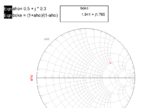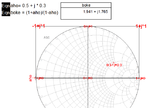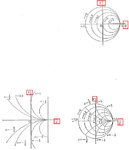Amir.Sk
Newbie level 6
However ADS draws aho not boke.
ADS surely draws the exact input value on the chart simply.
I'm correct
ADS simply draws the complex input it self.
THESE ARE ALL WRONG! :bang:
Really! You are wrong. :bang:
you have posted a picture with no numbers on its axes!
I've done the exact thing as you've done ( even your naming :-D ) but with axis data VISIBLE.
look the attachment!
look at numbers. It's BOKE! NOT AHO!! :bang:
It is drawing the corresponding Impedance of the input Reflection coefficient!
and forget about the Marker! It's Not and wasn't my case at all! No problem about the marker!
My Friend, Please take a precise look.
And
Surely send Results with Numbered Axes.
Smith Chart is a Graphical Representation of Complex Quantities so every kind of Complex Quantities can be read such as Impedance,Admittance,Reflection Coefficients,s-parameters etc.
I'm Total agree with what you said but our problem is not concerned with it.
We are simply arguing on whether ADS Smith Chart draws simply the input itself OR take the input as a reflection coefficient and draws its normalized corresponding Impedance! If you can help and try it once with your ADS, It will be a great help.


